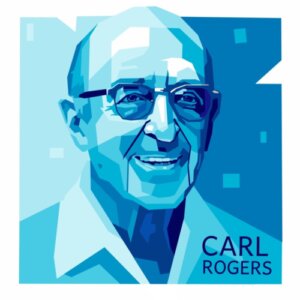Carl Rogers, Biography of a Humanist


Reviewed and approved by the psychologist Sergio De Dios González
Carl Rogers (1902-1987) is considered one of the most important psychotherapists of the 20th century. In fact, he equals luminaries such as Sigmund Freud in this field. Although he also has his detractors, few dare to question the impact of his work within the history of psychology.
This psychotherapist developed his work at a time when there were basically only two branches. These were behaviorism and psychoanalysis. However, in practice, many psychotherapists discovered that these two paradigms weren’t always effective. Rogers developed a new path that remains in force today.
Along with Abraham Maslow, Rogers is considered the founder of humanistic psychology. This approach is based on empathy and respect for clients who come to therapy. His model is known as client-centered therapy or person-centered therapy.
“I feel moved and fulfilled when I glimpse the fact, or allow myself the feeling, that someone cares about me, accepts me, admires me or praises me.”
-Carl Rogers-
His origins
Carl Rogers was born on January 8, 1902, in Oak Park (Illinois, United States), a suburb near Chicago. He was the fourth of six siblings. His father was a prestigious civil engineer and his mother was a traditional housewife. In his family, there was a strong religious tendency that Rogers defined as “very strict and intransigent”.
He learned to read really early. For this reason, he started his primary education in the second grade. When he was 12 years old, the family moved to a farm 30 miles from Chicago. Apparently, his parents sought to keep their boys away from “the temptations of suburban life”.
Rogers spent his entire adolescence there. He developed two great interests that he continued to pursue throughout his life: butterflies and agriculture. In fact, it’s said that they were his introduction to science. Otherwise, he was a rather lonely young man, quite independent and disciplined.

From farm work to psychology
In 1919, Rogers began studies in agricultural sciences at the University of Wisconsin. However, he then changed to study history. Later, he began training in theology and attended a seminary since he believed he had a priestly vocation. In 1922, he was selected to participate in an international conference of the World Student Christian Federation, in China.
The event lasted six months. During this time, he started to change his ideas. More particularly, eastern culture led him to doubt some basic aspects of his own religion.
Upon returning to the United States, he resumed his history studies and graduated. Shortly after, he married Helen Elliott, whom he’d known since childhood. He also attended another theological seminary in New York. Later, he commenced studies in educational psychology at Columbia University. He obtained his doctorate in psychology in 1931 and had a brilliant career in this area ever since.

Some important contributions of Carl Rogers
Initially, Rogers was greatly influenced by the great thinkers of his time. He began his clinical practice in the Child Studies Department of the Society for the Prevention of Cruelty to Children. It was there he discovered that theoretical paradigms weren’t always so effective in certain concrete cases.
After 12 years of working with juvenile delinquents, he taught several courses at the University of Rochester. In 1940, he entered Ohio University as a professor. By then, he was aware that he’d developed a new model of psychotherapeutic care. Later, his first publications appeared. They aroused both criticism and interest.
Dr. Rogers prescribed three keys to successful psychotherapy. These were empathic understanding, unconditional positive acceptance, and congruence. The latter was the most important and also the most complex. It assumes that there’s not much distance between how someone is and how they should be. In other words, there’s a synchronization between what they do and their authentic self.
Rogers not only turned psychotherapy on its head but also developed a theory of personality. He also proposed the model of non-directivity in pedagogy. He wrote until the end of his life, in 1987. His most notable work was Client-Centered Therapy, published in 1951. Rogers received numerous awards. Today, he’s remembered as one of the greats of psychology.
All cited sources were thoroughly reviewed by our team to ensure their quality, reliability, currency, and validity. The bibliography of this article was considered reliable and of academic or scientific accuracy.
- Brazier, D. (1997). Más allá de Carl Rogers (pp. 67-83). Desclée de Brouwer.
- Villegas i Besora, M. (1986). Psicologia humanística. Universitat de Barcelona. Anuario de Psicología, (1)34, p. 7-45. https://diposit.ub.edu/dspace/handle/2445/96920
This text is provided for informational purposes only and does not replace consultation with a professional. If in doubt, consult your specialist.








